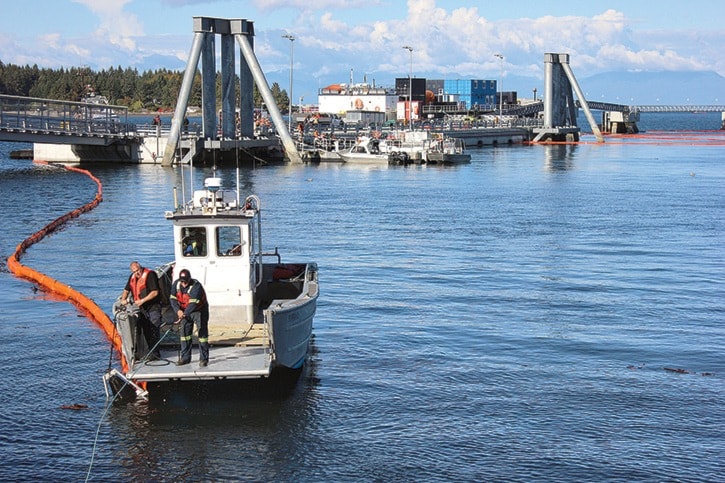Marine response units spent the past two days cleaning up a major diesel spill in the Nanaimo harbour after a large passenger vessel slammed into a pier at the city’s cruise ship terminal.
Fortunately, the passenger vessel crash and resulting oil spill didn’t actually occur, but the response to such an event was very real.
On Tuesday and Wednesday, more than 30 members from the Nanaimo Port Authority, Western Canada Marine Response Corporation, an organization contracted out by Transport Canada, and other agencies participated in a simulated oil response exercise near the cruise ship terminal.
Michael Lowry, communications manager with marine response, told the News Bulletin on Tuesday that the two-day exercise is unique as very few people knew about it ahead of time, adding that it’s the first time an unannounced oil response drill has been conducted in Nanaimo and by his organization.
“We’ve never really done an exercise where our guys are coming in cold. This is our first unannounced exercise,” he said. “Our responders woke up this morning, saw their phone that said they got a spill in the Nanaimo Harbour.”
Western Canada Marine is responsible for cleaning up spills along B.C.’s coast, according to Lowry, who said it is typically notified about a spill from either the operator or the coast guard.
During the Nanaimo exercise, responders mapped out the location and contained the site. Crews also mapped out environmentally sensitive parts of the harbour, such as the mouth of the Nanaimo River.
“It’s illegal for us to put any oil into the water,” Lowry said. “What we have our computer models that show us the trajectory of where the oil is going to be and that is how we will deploy our responders.”
Lowry said roughly 10 vessels, including a large multiple-purpose barge, from his organization participated as well as a half-dozen contractor vessels. He said the barge serves as an oil recovery unit as well as an office.
“If there is a spill offshore we would go out there and as we are offloading oil, we would offload it into that barge,” he said.
Lowry said the exercise is also an opportunity for his organization to work with agencies such as the Nanaimo Port Authority, adding that partnership is key to an effective response.
“Partnership is a big part of spill response.”
